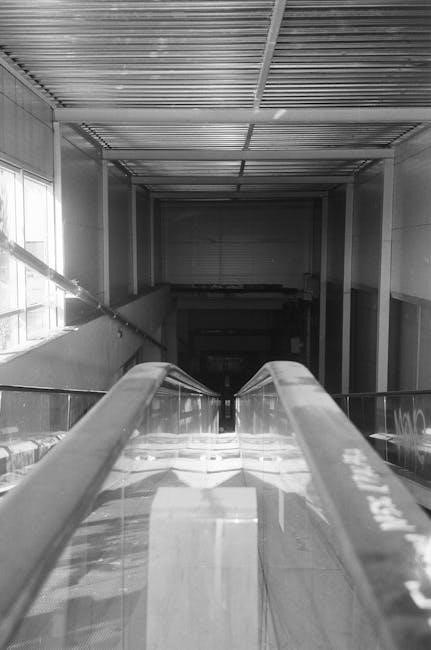elevator guide rail
Elevator guide rails are essential components that ensure smooth vertical movement of elevators, providing alignment, stability, and safety for passengers and cargo in various elevator systems worldwide․
Overview of Elevator Guide Rails
Elevator guide rails are critical structural components that ensure the smooth operation of elevator systems by providing alignment and stability․ They are mounted along the elevator shaft and guide the elevator car and counterweight as they move between floors․ Available in various designs and materials, guide rails are tailored to meet the specific needs of different elevator types, including passenger, freight, and high-speed systems․ Proper installation and maintenance of these rails are essential to prevent wear and tear, ensuring safe and efficient elevator performance․ Their durability and precision play a key role in maintaining passenger safety and operational reliability, making them indispensable in modern and traditional elevator systems alike․
History and Evolution of Elevator Guide Rails
The concept of elevator guide rails emerged during the mid-19th century, evolving from basic wooden tracks to modern steel and aluminum systems, revolutionizing elevator safety and efficiency․
Development of Early Elevator Systems
The development of early elevator systems was driven by the need for efficient vertical transportation in industrial and urban settings․ In the mid-19th century, inventors like Elisha Otis introduced safety mechanisms that laid the foundation for modern elevators․ These early systems relied on rudimentary guide rails made of wood and later steel, which provided basic alignment for elevator cars․ As technology advanced, so did the design and materials used for guide rails, leading to improved stability and safety․ The integration of hydraulic and traction systems further enhanced elevator performance, marking the beginning of a new era in vertical transportation solutions․

Types of Elevator Guide Rails
Elevator guide rails are categorized into hydraulic and traction types, each designed to support specific elevator systems, ensuring smooth operation and alignment in various building applications․
Hydraulic Elevator Guide Rails
Hydraulic elevator guide rails are specifically designed to support the movement of hydraulic elevator systems․ These rails are typically made of high-strength steel and are installed in the elevator shaft to provide alignment and stability for the elevator car․ Unlike traction elevators, hydraulic systems rely on a piston and cylinder to move the car, and the guide rails play a critical role in ensuring smooth operation․ They are engineered to withstand the forces exerted by the hydraulic system and maintain precise alignment, reducing wear and tear on the elevator components․ The design of hydraulic guide rails also incorporates safety features to prevent misalignment and ensure passenger safety․ Regular maintenance of these rails is essential to maintain the efficiency and reliability of the hydraulic elevator system․
Traction Elevator Guide Rails
Traction elevator guide rails are integral to the operation of traction elevator systems, which use ropes and counterweights for movement․ These rails are installed in the elevator shaft and guide the elevator car and counterweight, ensuring smooth and precise vertical motion․ Unlike hydraulic systems, traction elevators rely on the interaction between the guide rails and the elevator car’s rollers to maintain alignment and stability․ The rails are typically made of high-strength steel and are designed to minimize wear and noise․ Proper installation and alignment of traction elevator guide rails are critical for safe and efficient operation, especially in high-rise buildings where traction systems are commonly used․ Regular maintenance is essential to prevent wear and ensure optimal performance over time․
Materials Used for Elevator Guide Rails
Steel and aluminum are commonly used for elevator guide rails due to their durability, strength, and resistance to wear, ensuring reliable performance in various elevator systems․

Steel Guide Rails
Steel guide rails are widely used in elevator systems due to their exceptional strength, durability, and load-bearing capacity․ They are ideal for high-rise buildings and heavy-duty applications, ensuring stability and alignment․ Steel rails are resistant to wear and tear, making them a reliable choice for long-term use․ Their rigid structure minimizes deflection, providing smooth elevator movement․ Regular lubrication and inspection are essential to maintain their performance and extend lifespan․ Steel guide rails are often preferred in traction and hydraulic elevators, offering a balance of cost-effectiveness and reliability․ Their versatility and strength make them a cornerstone in modern elevator engineering, ensuring safety and efficiency in diverse environments․
Aluminum Guide Rails
Aluminum guide rails are a lightweight yet durable option for elevator systems, offering excellent corrosion resistance and a lower weight compared to steel․ They are often used in low- to medium-rise buildings and light-duty applications, providing a cost-effective solution․ Aluminum rails are easier to install and maintain, reducing labor costs․ Their smooth surface ensures minimal friction, contributing to energy efficiency․ While less load-bearing than steel, aluminum guide rails are ideal for residential elevators, small commercial lifts, and modernization projects․ They are also eco-friendly, as aluminum is fully recyclable․ Regular cleaning and lubrication are recommended to maximize their lifespan and performance in various elevator configurations․

Design and Engineering Considerations
Design and engineering of elevator guide rails focus on load capacity, alignment precision, and material durability to ensure smooth operation and safety across various elevator systems globally․
Load-Bearing Capacity of Guide Rails
Load-bearing capacity is a critical factor in elevator guide rails, determining the maximum weight they can support without compromising safety or performance․ This capacity is influenced by material strength, rail cross-sectional design, and the specific elevator system type․ For instance, high-speed elevators require guide rails with higher load-bearing capacities to handle increased stress from rapid acceleration and deceleration․ Manufacturers often conduct rigorous testing to ensure rails meet specified load limits, preventing potential risks like misalignment or wear-induced malfunctions․ Accurate calculation and adherence to safety standards are essential to maintain reliability and passenger safety across various elevator applications․
Alignment and Precision in Guide Rail Installation
Proper alignment and precision are paramount during the installation of elevator guide rails to ensure smooth operation and prevent mechanical failures․ Misaligned rails can lead to uneven wear, increased friction, and potential safety hazards․ Technicians use advanced tools, such as laser alignment systems, to achieve exact positioning and secure the rails firmly in place․ Precision installation minimizes the risk of elevator malfunctions, ensuring consistent performance and extending the lifespan of both the guide rails and the elevator system․ Regular inspections and adjustments are also crucial to maintain alignment integrity over time, safeguarding the reliability and safety of the elevator for all users․ This attention to detail is fundamental in modern elevator engineering․

Safety Standards and Regulations
Elevator guide rails must comply with strict international safety codes, such as ASME and EN standards, ensuring reliability, durability, and passenger safety through regular inspections and adherence to regulations․
International Safety Standards for Elevator Guide Rails
International safety standards for elevator guide rails, such as ASME A17․1 in the U․S․ and EN 81 in Europe, ensure elevators operate safely worldwide․ These standards specify requirements for guide rail materials, dimensions, and installation to prevent failures․ They also address load-bearing capacity, alignment precision, and resistance to wear․ Regular inspections and maintenance protocols are mandated to maintain safety․ Compliance with these standards is crucial for manufacturers to access global markets․ By adhering to these regulations, elevator systems meet rigorous safety benchmarks, protecting passengers and ensuring reliable operation across diverse environments․ These standards continuously evolve to incorporate advancements in technology and address emerging safety challenges in the elevator industry․
Regulatory Compliance in Guide Rail Manufacturing
Regulatory compliance in guide rail manufacturing ensures adherence to global safety and quality standards․ Manufacturers must meet stringent requirements set by bodies like ASME and EN, covering material strength, dimensional accuracy, and durability․ Third-party inspections and certifications are often mandatory to verify conformity․ Documentation, including material test reports and production records, must be maintained for traceability․ Compliance also involves environmental and ethical standards, such as sustainable practices and labor rights․ By adhering to these regulations, manufacturers ensure their products are safe, reliable, and marketable worldwide․ Non-compliance can result in legal penalties, reputational damage, and restricted market access․ Thus, regulatory compliance is a cornerstone of responsible guide rail production․

Installation and Maintenance of Guide Rails
Proper installation ensures alignment and stability, while regular maintenance, including lubrication and inspection, prolongs guide rail lifespan and guarantees safe elevator operation and performance over time․
Step-by-Step Guide Rail Installation Process
The installation begins with measuring and marking the elevator shaft walls to ensure precise alignment․ Next, the guide rails are securely fastened using anchor bolts․ Following this, the elevator car and counterweight are carefully aligned with the rails to ensure proper fitment․ After alignment, the safety brakes are installed to prevent accidental movement; Finally, a thorough inspection is conducted to verify all components are correctly positioned and functioning as intended․ Regular maintenance is then scheduled to uphold performance and safety standards․
Maintenance Tips for Prolonging Guide Rail Lifespan
Regular lubrication of moving parts is essential to reduce friction and wear․ Inspect guide rails for alignment issues and tighten loose fasteners promptly․ Clean the rails to remove dirt or debris that could cause damage․ Schedule periodic inspections to identify and replace worn or corroded components․ Use protective coatings to prevent rust and corrosion in humid environments․ Avoid overloading the elevator, as excessive weight can strain the guide rails․ Document maintenance activities to ensure consistency and compliance with safety standards․ By adhering to these practices, guide rails can maintain optimal performance and longevity, ensuring reliable elevator operation and passenger safety․
Role of Guide Rails in Different Elevator Types
Guide rails play a crucial role in various elevator types, ensuring stability and alignment in high-speed, freight, and passenger elevators, enhancing safety, and optimizing performance across diverse applications․
High-Speed Elevator Guide Rails
High-speed elevator guide rails are specially designed to support extreme velocities, ensuring stability and alignment in rapid transit systems․ These rails are crafted from high-strength materials like steel or advanced alloys, offering exceptional durability and resistance to wear․ Their unique design minimizes friction and vibration, enabling smooth operation at speeds exceeding 300 meters per minute․ Safety features, such as redundant braking systems and precision engineering, are integral to these rails, ensuring passenger safety and system reliability․ The alignment of these rails is critical, requiring meticulous installation and maintenance to maintain optimal performance․ Noise reduction technologies are also incorporated to enhance passenger comfort․ High-speed elevator guide rails are indispensable in modern skyscrapers and urban transit systems, where efficiency and safety are paramount․ Their advanced engineering ensures they meet the demands of high-speed applications while maintaining energy efficiency and operational longevity․
Freight Elevator Guide Rails
Freight elevator guide rails are robust components designed to handle heavy loads and ensure smooth operation in industrial and commercial settings․ These rails are typically made from durable materials like steel, offering exceptional strength and resistance to wear․ Unlike passenger elevators, freight elevators require guide rails that can withstand constant stress from bulky cargo and machinery․ Their design emphasizes stability and alignment, preventing misleveling and ensuring safe cargo transport․ Advanced safety features, such as reinforced brackets and enhanced lubrication systems, are often integrated to minimize friction and extend lifespan․ Regular maintenance is crucial to prevent corrosion and wear, ensuring reliable performance over time․ Freight elevator guide rails play a vital role in facilitating efficient material handling in warehouses, factories, and high-rise buildings․

Modern Advancements in Guide Rail Technology
Modern advancements in guide rail technology focus on automation, smart systems, and energy-efficient designs, enhancing performance, safety, and sustainability in elevator operations globally․
Automation and Smart Guide Rail Systems
Automation and smart guide rail systems integrate advanced technologies like IoT and real-time monitoring to optimize elevator performance․ These systems enable predictive maintenance, reducing downtime and enhancing safety․ By leveraging sensors and data analytics, they detect potential issues before they occur, ensuring smoother operations․ Smart guide rails also improve energy efficiency by adjusting elevator movement based on demand․ Automation minimizes the need for manual oversight, allowing for seamless integration with building management systems; These innovations not only boost reliability but also contribute to a more sustainable and efficient transportation solution within modern buildings․ As technology evolves, smart guide rail systems are becoming indispensable in the elevator industry․
Energy-Efficient Guide Rail Designs
Energy-efficient guide rail designs focus on minimizing energy consumption while maintaining optimal performance․ These systems often incorporate lightweight, high-strength materials such as aluminum or optimized steel alloys, which reduce the overall weight and friction during elevator operation․ Advanced coatings and surface treatments further enhance energy efficiency by lowering friction resistance․ Additionally, streamlined shapes and designs reduce air resistance, especially in high-speed elevators․ Some modern systems integrate smart technology to adjust guide rail alignment dynamically, optimizing energy use based on real-time conditions․ Eco-friendly materials and production methods are also prioritized to reduce environmental impact․ By combining innovative engineering and sustainable practices, energy-efficient guide rail designs contribute to greener, more cost-effective elevator systems for modern buildings․

Environmental Impact of Elevator Guide Rails
Elevator guide rails, made from steel or aluminum, have environmental impacts due to mining, energy use, and waste, though sustainable practices are reducing these effects․
Sustainable Materials in Guide Rail Production
The use of sustainable materials in guide rail production is growing, with manufacturers opting for recycled steel and aluminum to reduce environmental impact․ These materials retain strength and durability while minimizing resource depletion․ Energy-efficient manufacturing processes are also being adopted to lower carbon emissions․ Additionally, some companies are exploring the use of lightweight, eco-friendly alloys that offer similar performance to traditional metals․ Regulatory standards encourage the adoption of green technologies, promoting a shift toward sustainable practices in the industry․ By prioritizing recyclable and responsibly sourced materials, guide rail production is becoming more environmentally friendly, aligning with global sustainability goals․
Recycling and Reuse of Guide Rails
Recycling and reusing elevator guide rails contribute significantly to environmental sustainability․ Many guide rails are made from recyclable materials like steel and aluminum, which can be melted down and repurposed for new products․ This reduces the need for raw material extraction and lowers production costs․ Manufacturers are increasingly adopting recycling programs to minimize waste and promote eco-friendly practices․ Reused guide rails are often refurbished to meet safety and performance standards, extending their lifespan․ This approach not only conserves resources but also aligns with global efforts to reduce industrial waste and carbon emissions․ Recycling guide rails is a key step toward a more sustainable future for elevator systems and beyond․

Challenges in Guide Rail Manufacturing
Manufacturers face challenges in ensuring material durability, wear resistance, and cost-effectiveness while maintaining safety and performance standards for elevator guide rails․
Material Durability and Wear Resistance
Material durability and wear resistance are critical challenges in manufacturing elevator guide rails․ The rails must withstand heavy loads, frequent use, and environmental factors without compromising performance․ Steel and aluminum alloys are commonly used due to their strength and durability, but they still face wear from friction and mechanical stress․ Over time, this can lead to misalignment and safety hazards․ Manufacturers must balance material strength with cost-effectiveness to ensure longevity while meeting industry standards․ Advanced coatings and surface treatments are often applied to enhance resistance to corrosion and wear, extending the lifespan of the guide rails․ Addressing these challenges ensures reliable and safe elevator operations․
Cost-Effectiveness in Guide Rail Production
Cost-effectiveness is a significant challenge in the production of elevator guide rails, as manufacturers must balance quality, durability, and affordability․ The selection of materials, such as steel or aluminum, plays a crucial role in controlling costs while maintaining performance․ Advanced manufacturing techniques, including automation, help reduce production expenses and improve efficiency․ Additionally, optimizing production processes minimizes waste and lowers overall costs․ Suppliers must also provide materials at competitive rates without compromising quality․ By streamlining production workflows and leveraging cost-efficient technologies, manufacturers can ensure guide rails are both durable and economically viable for various elevator systems․ This balance is essential for meeting market demands and ensuring long-term sustainability․

Future Trends in Elevator Guide Rail Development
Future trends include innovative materials, smart technologies, and energy-efficient designs, enhancing durability, safety, and sustainability in elevator guide rail systems for modern and high-performance applications․
Innovative Materials and Designs
The development of innovative materials and designs for elevator guide rails focuses on enhancing durability, reducing weight, and improving energy efficiency․ Advanced alloys, such as high-strength steel and titanium, are being utilized to create lighter yet stronger guide rails․ Additionally, researchers are exploring the use of carbon fiber and other composite materials to achieve superior performance and corrosion resistance․ Novel designs, including modular and adaptable guide rail systems, are being introduced to cater to diverse elevator applications, from high-speed elevators to heavy-duty freight systems․ These advancements aim to minimize wear and tear, reduce maintenance needs, and ensure smoother operation․ The integration of smart materials that can adapt to environmental changes is also being considered, promising even greater reliability and safety in the future․
Integration with Smart Building Technologies
The integration of elevator guide rails with smart building technologies is revolutionizing the way elevators operate․ Modern systems now incorporate sensors and IoT devices that monitor guide rail wear and tear, enabling predictive maintenance․ These technologies optimize elevator performance by adjusting alignment and tension in real-time․ Integration with building management systems allows seamless communication between elevators and other infrastructure, enhancing energy efficiency and user experience․ Additionally, smart guide rails can adapt to varying loads and usage patterns, reducing energy consumption․ This fusion of hardware and software ensures safer, more efficient, and responsive elevator systems, aligning with the growing demand for intelligent and sustainable buildings․
Elevator guide rails are critical to ensuring safe, efficient, and smooth vertical transportation․ Their design, materials, and integration with smart technologies continue to evolve, enhancing performance and sustainability․
Elevator guide rails are indispensable for ensuring the stability, alignment, and safety of elevator systems․ They are crafted from durable materials like steel and aluminum to withstand heavy loads and prolonged use․ Guide rails play a pivotal role in both hydraulic and traction elevators, providing the necessary structural support for smooth operation․ Their design must adhere to strict safety standards and regulations to guarantee passenger safety․ Proper installation and regular maintenance are crucial for extending their lifespan․ Advances in technology have introduced smart and energy-efficient guide rail systems, enhancing performance and sustainability․ As the demand for reliable vertical transportation grows, the evolution of guide rail technology remains a cornerstone of modern elevator systems․